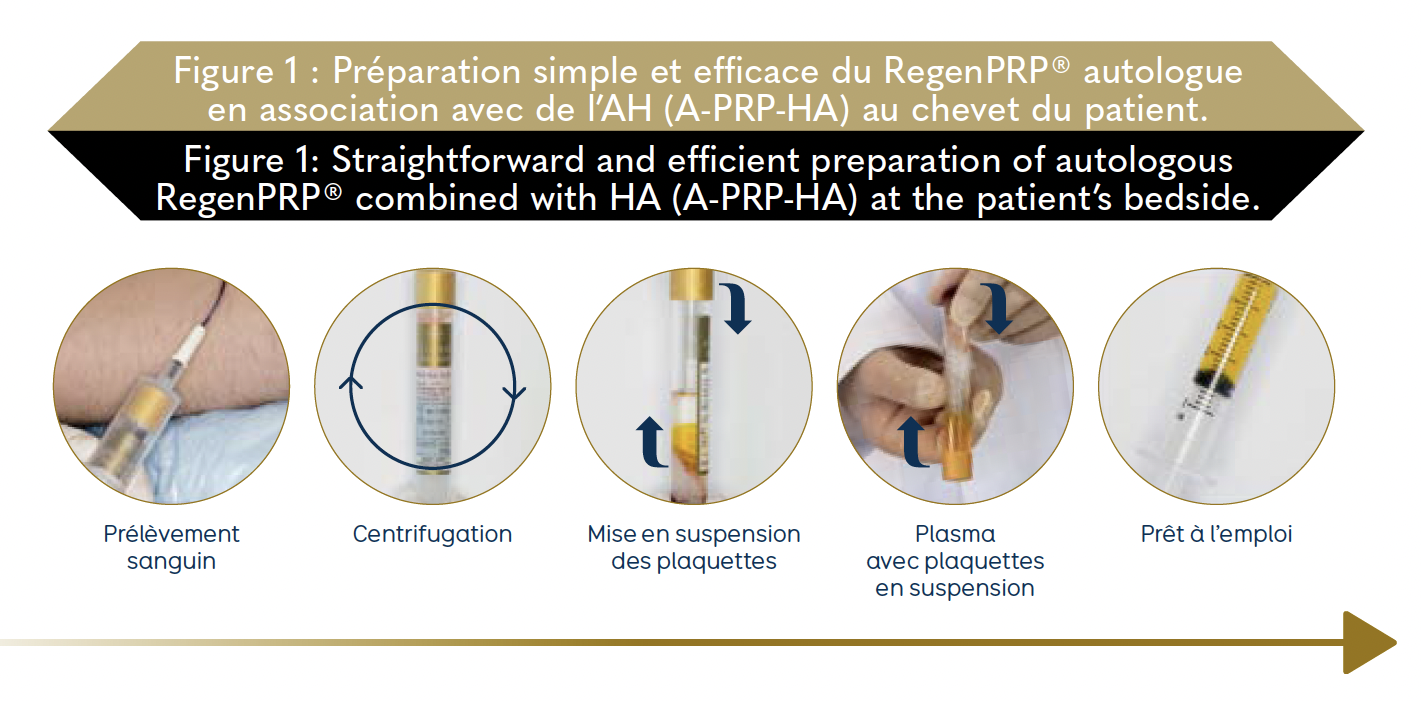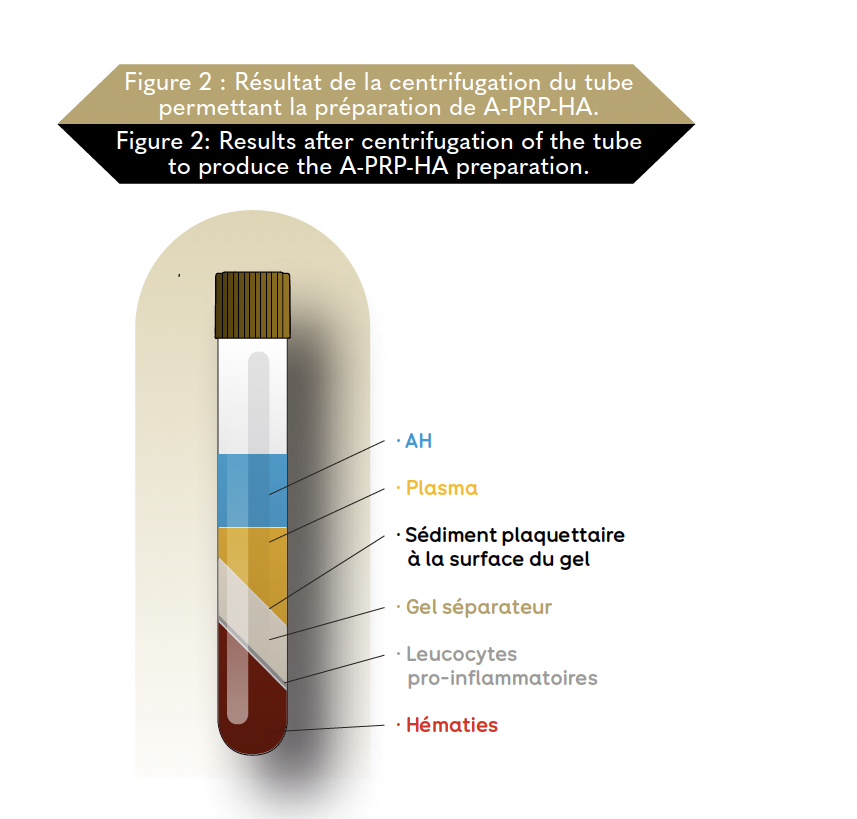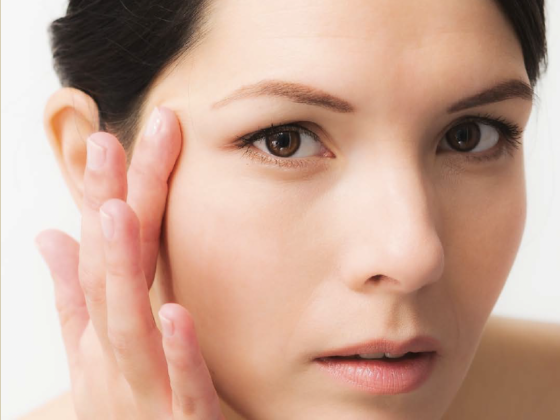Dr Barbara Hersant
Vulvovaginal atrophy (VVA) mainly occurs after the menopause due to a spectacular drop in the levels of oestrogen in circulation.
 Between 45 and 57% of menopausal women suffer from discomfort due to VVA. The symptoms of VVA include a loss of vaginal lubrication, which leads to vaginal dryness followed by other symptoms such as burning, itching, bleeding, leucorrhoea and dyspareunia [1].
Between 45 and 57% of menopausal women suffer from discomfort due to VVA. The symptoms of VVA include a loss of vaginal lubrication, which leads to vaginal dryness followed by other symptoms such as burning, itching, bleeding, leucorrhoea and dyspareunia [1].
Technological platform for standardised autologous regenerative medicine
 What is RegenPRP®?:
What is RegenPRP®?:
Platelets, in addition to their role in haemostasis, are key factors in the tissue repair mechanisms [2]. They supply essential growth factors, such as FGF, PDGF, TGF-¥â, EGF, VEGF and IGF, which are involved in the migration, division and proliferation of stem cells. Platelet-borne growth factors also stimulate the fibroblasts and endothelial cells to activate the synthesis of a new extracellular matrix and neovascularisation.
Plasma contains many essential factors for cell survival, namely nutrients, vitamins, hormones, electrolytes, growth factors (such as IGF and HGF) and proteins. Among these plasmatic proteins there are vital molecules for the coagulation process and for the formation of fibrin polymers, which facilitate cell migration and the synthesis of new tissues [2-3].
RegenPRP® has a proven action on tissue healing, with a key role in cell migration, proliferation and differentiation. It also plays a key role in the synthesis of the new extracellular matrix for tissue regeneration.
 Characteristics of RegenPRP® combined with hyaluronic acid:
Characteristics of RegenPRP® combined with hyaluronic acid:
The closed-circuit process to separate the RegenPRP® from the blood cells is standardised and reproducible. The technology uses a chemically-inert thixotropic separator gel which allows the plasma, platelets and hyaluronic acid (HA) in the blood cells to be separated, to produce RegenPRP® combined with a standard-composition HA. The resulting preparation is called A-PRP-HA.
Before it is centrifuged, 4ml of blood is collected in a tube containing a pharmaceutical-quality reversible anticoagulant (sodium citrate) at pH7 which is present at the surface of the gel. The centrifugation is carried out at a force of 1,500g for 5 minutes. The centrifugation separates the blood components according to their density. The heavier red blood cells are trapped in the bottom of the tube by the separator gel. Next, the tube is turned upside down several times to spread the platelets that cover the gel and HA in the plasma (Figure 2).
Regenerative medicine based on clinical proof:
Around 50 to 70% of breast cancer survivors are affected by one or several symptoms of vulvovaginal atrophy (VVA). For those who cannot have hormone therapy, autologous platelet-rich plasma combined with hyaluronic acid (A-PRP-HA) can be an alternative therapy for treating VVA.
In a pilot clinical study, we looked at the efficacy of injecting RegenPRP® combined with HA in treating VVA in postmenopausal women with a history of breast cancer [1].
The 20 participants showed an improvement in the clinical symptoms of vaginal dryness and dyspareunia. The Vaginal Health Index (VHI) score showed a significant improvement after six months, compared with the total base score (pre-treatment) of 10.7 ± 2.12 to 20.75 ± 4.8 (P < 0.0001) after 6 months. An improvement in the vaginal epithelium’s hydration and integrity was reported. A VHI score of more than 15 showed a positive therapeutic result.
The Female Sexual Distress (FSD) score reduced significantly over the course of the study, from a base score of 36.35 ± 2.53 before treatment to 30.15 ± 2.47 six months after the treatment, which is a 17% improvement (P < 0.0001, respectively). No undesirable side-effects were noted.
Injecting A-PRP-HA seems to be a promising method for improving the trophicity and hydration of the vaginal mucous membrane to treat VVA in postmenopausal breast cancer survivors who present counter-indications to hormone therapy.
References
1. Hersant B, SidAhmed-Mezi M, Belkacemi Y, Darmon F, Bastuji-Garin S, Werkoff G, Bosc R, Niddam J, Hermeziu O, La Padula S, Meningaud JP. Efficacy of injecting platelet concentrate combined with hyaluronic acid for the treatment of vulvovaginal atrophy in postmenopausal women with history of breast cancer: a phase 2 pilot study. Menopause. 2018 Oct;25(10):1124-1130.
2. Fountain JH, Lappin SL. Physiology, Platelet. 2023 Jul 25. In: StatPearls [Internet]. Treasure Island (FL): StatPearls Publishing; 2024 Jan–.
3. Mathew J, Sankar P, Varacallo M. Physiology, Blood Plasma. 2023 Apr 24. In: StatPearls [Internet]. Treasure Island (FL): StatPearls Publishing; 2024 Jan–.
 Dr Barbara Hersant: MD PhD, Professor of plastic, aesthetic and reconstructive surgery at Henri-Mondor APHP Hospital, practises regenerative and reconstructive surgery on the body, face and genitals, as well as surgery and aesthetic medicine. Tenured member of the French Surgical Academy.
Dr Barbara Hersant: MD PhD, Professor of plastic, aesthetic and reconstructive surgery at Henri-Mondor APHP Hospital, practises regenerative and reconstructive surgery on the body, face and genitals, as well as surgery and aesthetic medicine. Tenured member of the French Surgical Academy.















